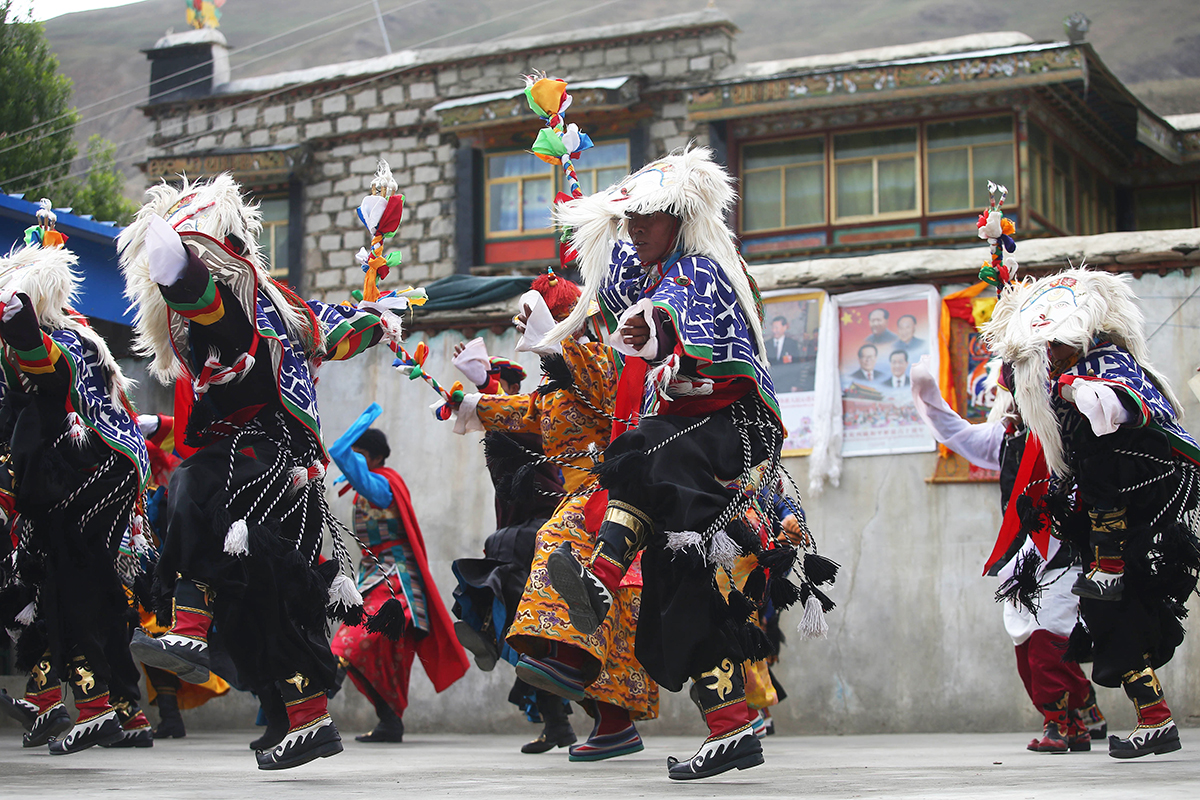Inscribed as an Intangible Cultural Heritage of Humanity by UNESCO in 2009, Tibetan opera is widely regarded as one of the finest opera forms in China. In true bucolic fashion, it is performed outside without a curtain or stage, relying entirely on the natural and effortless talent of its practitioners. The themes of Tibetan opera derive from a myriad of sources, from solemn Buddhist scripture and bold historical epics to grand legends and mystical folk tales. These lofty themes are intermingled with features of daily life in order to make each opera relatable to its audience. Even the origins of Tibetan opera itself were born out of purely practical needs!

It is believed that, during the 14th century, an eminent Buddhist monk named Thangtong Gyalpo had planned to build a number of bridges, which would enable people to easily cross all of the major rivers in Tibet. However, he simply couldn’t afford to embark on this noble project without funding. Using religious stories as inspiration, he wrote a number of operatic arias. With the help of seven sisters, he travelled across Tibet and organised performances of these operas to raise funds. In elaborate costumes, the girls would dance and sing while Thangtong accompanied them with a drum. In fact, the Tibetan name for this opera style, which is known as Ache lhamo or simply lhamo, translates to mean “Elder Sister Fairy” in reference to the ethereal beauty of these sisters.
Some of the bridges that Thangtong Gyalpo masterminded are still in use today, but by far his greatest legacy is the 700-year-old tradition of Tibetan opera. You could say he bridged a gap between the past and the present! While he remains credited for the creation and dissemination of Tibetan opera, it also incorporates features from ancient rituals associated with the indigenous religion of Bön, alongside aspects of traditional Tibetan folk dance. Many historians even argue that it was the Indian Buddhist master Padmasambhava who was responsible for the first performance of Tibetan opera. The inauguration ceremony he staged during the 8th century for the Tibetan king Trisong Detsen contained a variety of simple plays, which Thangtong Gyalpo used as the basis for his operas. As they say: bad artists borrow; good artists steal! By the 19th century, Tibetan opera troupes could be found throughout Tibet, and nowadays performances continue to be held, particularly on special occasions such as the Shoton Festival.
Opera costumes are typically made from silk, with royal characters wearing the stateliest outfits and lesser characters donning more modest attire. Hems and borders of clothes may be adorned with simple silk brocades, but the finest brocades are saved for the most important component of the costume: the mask. These colourful masks are bedecked with a sun and moon motif, and are used to identify certain character types. For example, dark red indicates a king; light red denotes a minister; yellow indicates the character is a Buddhist deity or monk; blue masks are for hunters; female characters wear green; ordinary male characters wear white; black signifies a villain; and a half white, half black mask symbolises a double-dealer. If only it were quite so simple in real life!
Performances of Tibetan opera typically take place outdoors in public squares, public parks, or temples, although nowadays some are staged indoors with a full complement of accoutrements, including backdrops, stage-lighting, make-up, and an orchestra. Before the performance can begin, a statue of Thangtong Gyalpo must be placed at the centre and the open air “stage” must be blessed. A narrator will sing a summary of the story, and then the performance will start. Talk about plot spoilers! At the beginning of each act, it is the narrator’s responsibility to quickly describe what is going to happen. In the absence of realistic backdrops and props, it is largely up to the narrator to stimulate the audience’s imagination and set the scene.
Once the performance is finished, another ritual blessing is conducted where the statue of Thangthong Gyalpo is honoured and presented with a hada by the performers. The plays vary vastly in length, with the shorter ones lasting several hours and the long ones taking upwards of two to three days to complete! Unlike other forms of Chinese opera, which employ large orchestras, Tibetan opera is usually only accompanied by drums and cymbals. Dance plays a major role in the production, shifting from the elegant to the brisk to the purely acrobatic depending on the action of the play.
Although Tibetan opera is now widely regarded as a secular art form, its deeply entrenched roots in Buddhism mean that many of its stories recount the triumph of good and the punishment of evil. In many ways, these performances serve as tools to teach a wide audience about the significance of morality. Yet the real beauty of Tibetan opera lies in its ability to connect Tibetans throughout the country, promoting unity and encouraging pride in their cultural identity. For centuries, Tibetans have gathered every summer at the Norbulingka in Lhasa to enjoy performances of Tibetan opera as part of the Shoton Festival. We can only hope that they can continue to do so for centuries to come.